Electric Vehicles and Biofuels Synergies in the Brazilian Energy System
Abstract
1. Introduction
2. Theoretical Background
2.1. Energy and Transport Sector in Brazil
2.2. Electric Vehicles (EVs)
3. Materials and Methods
4. Results and Discussion
4.1. Technical Analysis
4.2. Life-Cycle Assessment (LCA)
5. Conclusions
6. Limitations and Further Research
Author Contributions
Funding
Conflicts of Interest
Appendix A
| Energy PLAN Input Data | Scenario BAU | Scenario RES | Scenario Hydro Risk | Scenario 100EV | Ref. |
|---|---|---|---|---|---|
| Electricity Demand (TWh) | 1571 | 1571 | 1571 | 1571 | [39,57] |
| Fixed Import/Export (TWh) | 0.179 | 0.179 | 0.179 | 0.179 | [38] |
| Transmission Capacity (MW) | 9070 | 9070 | 9070 | 9070 | [19] |
| Installed Capacity—Intermittent (2050) (GW) | 149.7 | 299.3 | 299.3 | 299.3 | [39] |
| Installed Capacity—Other (2050) (GW) | 661.3 | 661.3 | 661.3 | 661.3 | [39] |
| Transport Consumption—Gasoline (TWh/year) | 347.2 | 347.2 | 347.2 | 0 | [24] |
| Transport Consumption—Biofuels (TWh/year) | 388.6 | 388.6 | 388.6 | 0 | [24] |
| Electric Vehicles Demand—(TWh/year) | 38.8 | 38.8 | 38.8 | 216.4 | [24,58,59] |
| Capacity of grid to battery connection (MW) | 23,625 | 23,625 | 23,625 | 262,500 | [24,45] |
| Battery storage capacity (GWh) | 713.7 | 713.7 | 713.7 | 7064 | [24,45] |
| Charge Rate of EVs (kW) | 6 | 6 | 6 | 6 | [45] |
| Description | Value | Ref. |
|---|---|---|
| WtT Emission Intensity Factor (g/MJ) for Petrol | 13.8 | [40] |
| WtT Emission Intensity Factor (g/MJ) for Ethanol | 18.1 | [40] |
| TtW Emission Intensity Factor (g/MJ) for Petrol | 69.8 | [40] |
| TtW Emission Intensity Factor (g/MJ) for Ethanol | 0 | [40] |
| CO2 Emissions from non-battery components per car (tonnes) | 3.2 | [40] |
| Vehicle Life (km) | 200,000 | [40] |
| Batteries in life-time for electric and hybrid vehicles (years) | 1.5 | [40] |
| Battery size—Electric (kWh) | 70.64 | [45] |
| Battery size—Hybrid (kWh) | 1.5 | [40] |
| Max share of cars during peak demand | 0.2 | [60] |
| Share of parked cars grid connected | 0.7 | [60] |
| Efficiency (grid to battery) | 0.9 | [60] |
| Charging strategy | Daily | [16] |
| Average distance travelled (km/year) | 11,700 | [58] |
| Average EVs consumption—2050 (kWh/km) | 0.148 | [59] |
| Charge Rate of EVs (kW) | 6 | [45] |
| CO2 by fuel (kg/GJ) Coal (Electricity Sector—EnergyPLAN input data) | 95 | [60] |
| CO2 by fuel (kg/GJ) Petrol (Electricity Sector—EnergyPLAN input data) | 74 | [60] |
| CO2 by fuel (kg/GJ) Natural Gas (Electricity Sector—EnergyPLAN input data) | 56.7 | [60] |
| Average battery manufacturing intensity (g/kWh) | 152,063 | [40] |
| Energy for recycling vehicles (MJ/kg) | 0.43 | [40] |
| Energy for recycling batteries (MJ/kg) | 469 | [40] |
| Mass of each car (kg) | 1200 | [40] |
| Average emissions factor reduction by using recycled battery materials (%) | 26.5 | [40] |
| Battery recycling rate in 2050 (%) | 100 | [40] |
| Vehicle-use portion of battery life (%) | 58.1 | [40] |
| Batteries in vehicle life | 1.5 | [40] |
| Extra life batteries can be used for after their vehicular use (%) | 72 | [40] |
References
- van Ruijven, B.J.; De Cian, E.; Sue Wing, I. Amplification of future energy demand growth due to climate change. Nat. Commun. 2019, 10. [Google Scholar] [CrossRef] [PubMed]
- Dranka, G.G.; Ferreira, P. Towards a smart grid power system in Brazil: Challenges and opportunities. Energy Policy 2020, 136. [Google Scholar] [CrossRef]
- Chu, S.; Majumdar, A. Opportunities and challenges for a sustainable energy future. Nature 2012, 488, 294–303. [Google Scholar] [CrossRef]
- Dranka, G.G.; Ferreira, P.; Vaz, A.I.F. Cost-effectiveness of energy efficiency investments for high renewable electricity systems. Energy 2020, 198, 117198. [Google Scholar] [CrossRef]
- Dranka, G.G.; Jorge, C.; de Lima, J.D.; Ferreira, P. Economic evaluation methodologies for renewable energy projects. AIMS Energy 2020, 8, 339–364. [Google Scholar] [CrossRef]
- IRENA. Synergies between Renewable Energy and Energy Efficiency; International Renewable Energy Agency: Masdar City, Abu Dhabi, 2017; pp. 1–121. [Google Scholar]
- Bellocchi, S.; Klöckner, K.; Manno, M.; Noussan, M.; Vellini, M. On the Role of Electric Vehicles towards Low-Carbon Energy Systems: Italy and Germany in Comparison. Energy Fuel Technol. 2019, 2019050331. [Google Scholar] [CrossRef]
- Dranka, G.G.; Ferreira, P. Review and assessment of the different categories of demand response potentials. Energy 2019, 179, 280–294. [Google Scholar] [CrossRef]
- Dranka, G.G.; Ferreira, P. Load flexibility potential across residential, commercial and industrial sectors in Brazil. Energy 2020, 201. [Google Scholar] [CrossRef]
- Longo, M.; Foiadelli, F.; Yaïci, W. Electric Vehicles Integrated with Renewable Energy Sources for Sustainable Mobility. In New Trends in Electrical Vehicle Powertrains; IntechOpen: London, UK, 2019. [Google Scholar]
- Ballinger, B.; Stringer, M.; Schmeda-Lopez, D.R.; Kefford, B.; Parkinson, B.; Greig, C.; Smart, S. The vulnerability of electric vehicle deployment to critical mineral supply. Appl. Energy 2019, 255, 113844. [Google Scholar] [CrossRef]
- IRENA. Innovation Outlook—Smart Charging for Electric Vehicles. Available online: https://www.irena.org//media/Files/IRENA/Agency/Publication/2019/May/IRENA_Innovation_Outlook_EV_smart_charging_2019.pdf (accessed on 12 November 2019).
- Wilson, L. Shades of Green: Electric Cars’ Carbon Emissions Around the Globe; Shrink That Footpr: Washington, DC, USA, 2013. [Google Scholar]
- Liu, W.; Hu, W.; Lund, H.; Chen, Z. Electric vehicles and large-scale integration of wind power—The case of Inner Mongolia in China. Appl. Energy 2013, 104, 445–456. [Google Scholar] [CrossRef]
- Lund, H.; Kempton, W. Integration of renewable energy into the transport and electricity sectors through V2G. Energy Policy 2008, 36, 3578–3587. [Google Scholar] [CrossRef]
- dos Santos Martins, M.M.M.M. Evaluation of Energy and Environmental Impacts of Electric Vehicles in Different Countries. Master’s Thesis, Técnico Lisboa, Lisboa, Portugal, 2015. [Google Scholar]
- Hassan, A.S.; Xydas, E.S.; Marmaras, C.E.; Cipcigan, L.M.; Jenkins, N. Integrating renewable energy with flexible storage systems: A case study of GB and Greece. In Proceedings of the 2013 48th International Universities’ Power Engineering Conference, Dublin, Iceland, 2–5 September 2013; Institute of Electrical and Electronics Engineers: New York, NY, USA, 2014. [Google Scholar]
- Dranka, G.G.; Ferreira, P. Planning for a renewable future in the Brazilian power system. Energy 2018, 164, 496–511. [Google Scholar] [CrossRef]
- ANEEL. Sistema de Informações de Geração da ANEEL; SIGA: Brasília, Brazil, 2020. [Google Scholar]
- EPE. Brazilian Energy Balance 2019: Base Year 2018. Available online: https://ben.epe.gov.br/ (accessed on 25 July 2019).
- REN21. Renewables 2019 Global Status Report; National Technical University of Athens (NTUA): Athens, Greece, 2019; ISBN 978-3-9818911-7-1. [Google Scholar]
- EPE. Análise de Conjuntura dos Biocombustíveis 2018; Ministério de Minas e Energia: Brasília, Brazil, 2018. [Google Scholar]
- Dorotić, H.; Doračić, B.; Dobravec, V.; Pukšec, T.; Krajačić, G.; Duić, N. Integration of transport and energy sectors in island communities with 100% intermittent renewable energy sources. Renew. Sustain. Energy Rev. 2019, 99, 109–124. [Google Scholar] [CrossRef]
- Lima, M.A.; Mendes, L.F.R.; Mothé, G.A.; Linhares, F.G.; de Castro, M.P.P.; da Silva, M.G.; Sthel, M.S. Renewable energy in reducing greenhouse gas emissions: Reaching the goals of the Paris agreement in Brazil. Environ. Dev. 2020, 100504. [Google Scholar] [CrossRef]
- EPE. Nota Técnica DEA 13/15—Demanda de Energia 2050. Available online: http://www.epe.gov.br/sites-pt/publicacoes-dados-abertos/publicacoes/PublicacoesArquivos/publicacao-227/topico-458/DEA13-15DemandadeEnergia2050.pdf (accessed on 19 February 2016).
- Cano, Z.P.; Banham, D.; Ye, S.; Hintennach, A.; Lu, J.; Fowler, M.; Chen, Z. Batteries and fuel cells for emerging electric vehicle markets. Nat. Energy 2018, 3, 279–289. [Google Scholar] [CrossRef]
- de Azevedo, T.R.; Costa Junior, C.; Brandão Junior, A.; Cremer, M.; dos Santos Cremer, M.; Piatto, M.; Tsai, D.S.; Barreto, P.; Martins, H.; Sales, M.; et al. SEEG initiative estimates of Brazilian greenhouse gas emissions from 1970 to 2015. Sci. Data 2018, 5, 180045. [Google Scholar] [CrossRef]
- Dominković, D.F.; Bačeković, I.; Pedersen, A.S.; Krajačić, G. The future of transportation in sustainable energy systems: Opportunities and barriers in a clean energy transition. Renew. Sustain. Energy Rev. 2018, 82, 1823–1838. [Google Scholar] [CrossRef]
- Emiliano, M.W.; Costa, L.; Carvalho, S.M.; Telhada, J.; A. Lanzer, E. Multiobjective optimization of transit bus fleets with alternative fuel options: The case of Joinville, Brazil. Int. J. Sustain. Transp. 2020, 14, 14–24. [Google Scholar] [CrossRef]
- Tarroja, B.; Zhang, L.; Wifvat, V.; Shaffer, B.; Samuelsen, S. Assessing the stationary energy storage equivalency of vehicle-to-grid charging battery electric vehicles. Energy 2016, 106, 673–690. [Google Scholar] [CrossRef]
- Li, P.; Hu, W.; Xu, X.; Huang, Q.; Liu, Z.; Chen, Z. A frequency control strategy of electric vehicles in microgrid using virtual synchronous generator control. Energy 2019, 189, 116389. [Google Scholar] [CrossRef]
- Islam, M.M.; Zhong, X.; Sun, Z.; Xiong, H.; Hu, W. Real-time frequency regulation using aggregated electric vehicles in smart grid. Comput. Ind. Eng. 2019, 134, 11–26. [Google Scholar] [CrossRef]
- Bañol Arias, N.; Hashemi, S.; Andersen, P.B.; Træholt, C.; Romero, R. Assessment of economic benefits for EV owners participating in the primary frequency regulation markets. Int. J. Electr. Power Energy Syst. 2020, 120, 105985. [Google Scholar] [CrossRef]
- Musio, M.; Porru, M.; Serpi, A.; Marongiu, I.; Damiano, A. Optimal Electric Vehicle charging strategy for energy management in microgrids. In Proceedings of the 2014 IEEE International Electric Vehicle Conference, IEVC 2014, Florence, Italy, 17–19 December 2014; Institute of Electrical and Electronics Engineers Inc: Piscataway, NJ, USA, 2014. [Google Scholar]
- Zethmayr, J.; Kolata, D. Charge for Less: An Analysis of Hourly Electricity Pricing for Electric Vehicles. World Electr. Veh. J. 2019, 10, 6. [Google Scholar] [CrossRef]
- Østergaard, P.A. Reviewing EnergyPLAN simulations and performance indicator applications in EnergyPLAN simulations. Appl. Energy 2015, 154, 921–933. [Google Scholar] [CrossRef]
- EnergyPLAN—Advanced Energy System Analysis Computer Model. Available online: http://www.energyplan.eu/ (accessed on 9 October 2017).
- ONS Brazilian National Grid Operator. Available online: http://www.ons.org.br/Paginas/resultados-da-operacao/historico-da-operacao (accessed on 7 May 2018).
- PCE. Cenários Para a Matriz Elétrica 2050: Aporte ao Debate Energético Nacional e ao Planejamento Participativo de Longo Prazo; PCE Brasil 2050. Available online: http://www.nextrans.com.br/wp-content/uploads/2015/03/Energia-Cenarios-2050.pdf (accessed on 5 October 2017).
- Glensor, K.; María Rosa Muñoz, B. Life-cycle assessment of Brazilian transport biofuel and electrification pathways. Sustainability 2019, 11, 6332. [Google Scholar] [CrossRef]
- Pfenninger, S.; Staffell, L. Renewables Ninja. Available online: www.renewables.ninja (accessed on 14 November 2017).
- Pfenninger, S.; Staffell, L. Long-term patterns of European PV output using 30 years of validated hourly reanalysis and satellite data. Energy 2016, 114, 1251–1265. [Google Scholar] [CrossRef]
- Staffell, L.; Pfenninger, S. Using Bias-Corrected Reanalysis to Simulate Current and Future Wind Power Output. Energy 2016, 114, 1224–1239. [Google Scholar] [CrossRef]
- EPE. Brazilian Energy Balance 2017: Base Year 2016. Available online: https://ben.epe.gov.br/ (accessed on 5 March 2018).
- de Almeida, A.S.F. The Role of Electric Vehicles Second-Life Batteries on Renewable Based Power Systems. Master’s Thesis, Universidade de Lisboa, Lisbon, Portugal, 2018. [Google Scholar]
- de Lucena, A.F.P.; Szklo, A.S.; Schaeffer, R.; de Souza, R.R.; Borba, B.S.M.C.; da Costa, I.V.L.; Júnior, A.O.P.; da Cunha, S.H.F. The vulnerability of renewable energy to climate change in Brazil. Energy Policy 2009, 37, 879–889. [Google Scholar] [CrossRef]
- Rochedo, P.R.R.; Soares-Filho, B.; Schaeffer, R.; Viola, E.; Szklo, A.; Lucena, A.F.P.; Koberle, A.; Davis, J.L.; Rajão, R.; Rathmann, R. The threat of political bargaining to climate mitigation in Brazil. Nat. Clim. Chang. 2018, 8, 695–698. [Google Scholar] [CrossRef]
- Zambon, R.C. A operação dos reservatórios e o planejamento da operação hidrotérmica do Sistema Interligado Nacional. Rev. USP 2015, 133–144. [Google Scholar] [CrossRef][Green Version]
- Institute, W.R. Water Risk Atlas. Available online: https://www.wri.org/applications/aqueduct/water-risk-atlas (accessed on 3 December 2019).
- Chen, X.; Tan, C.-W.; Kiliccote, S.; Rajagopal, R. Electric vehicle charging during the day or at night: A perspective on carbon emissions. arXiv 2019, arXiv:1811.07984. [Google Scholar]
- Liu, L.; Kong, F.; Liu, X.; Peng, Y.; Wang, Q. A review on electric vehicles interacting with renewable energy in smart grid. Renew. Sustain. Energy Rev. 2015, 51, 648–661. [Google Scholar] [CrossRef]
- Mwasilu, F.; Justo, J.J.; Kim, E.-K.; Do, T.D.; Jung, J.-W. Electric vehicles and smart grid interaction: A review on vehicle to grid and renewable energy sources integration. Renew. Sustain. Energy Rev. 2014, 34, 501–516. [Google Scholar] [CrossRef]
- Graves, C.; Ebbesen, S.D.; Mogensen, M.; Lackner, K.S. Sustainable hydrocarbon fuels by recycling CO2 and H2O with renewable or nuclear energy. Renew. Sustain. Energy Rev. 2011, 15, 1–23. [Google Scholar] [CrossRef]
- APS Physics. Direct Air Capture of CO2 with Chemicals—A Technology Assessment for the APS Panel on Public Affairs. Available online: https://www.aps.org/policy/reports/assessments/upload/dac2011.pdf (accessed on 5 December 2019).
- Iacobucci, R.; McLellan, B.; Tezuka, T. The Synergies of Shared Autonomous Electric Vehicles with Renewable Energy in a Virtual Power Plant and Microgrid. Energies 2018, 11, 2016. [Google Scholar] [CrossRef]
- Jones, E.C.; Leibowicz, B.D. Contributions of shared autonomous vehicles to climate change mitigation. Transp. Res. Part D Transp. Environ. 2019, 72, 279–298. [Google Scholar] [CrossRef]
- PCE. Metodologia Para Elaboração e Validação dos Cenários Elétricos—Plataforma Cenários Energéticos. Available online: http://viex-americas.com/cortex/wwf/pce/metodologia/ (accessed on 17 November 2017).
- KBB. Average Distance Travelled (km/year) by Vehicles in Brazil. Available online: https://www.kbb.com.br/detalhes-noticia/quanto-brasileiro-roda-carro-ano/?ID=1830 (accessed on 4 December 2019).
- Zushman, J.M. Modelling Greenhouse Gas Emissions from Light Duty Vehicles. Bachelor’s Thesis, University of Iceland, Reykjavik, Iceland, 2016. [Google Scholar]
- Lund, H. EnergyPLAN—Documentation. Available online: http://www.energyplan.eu/ (accessed on 4 December 2019).
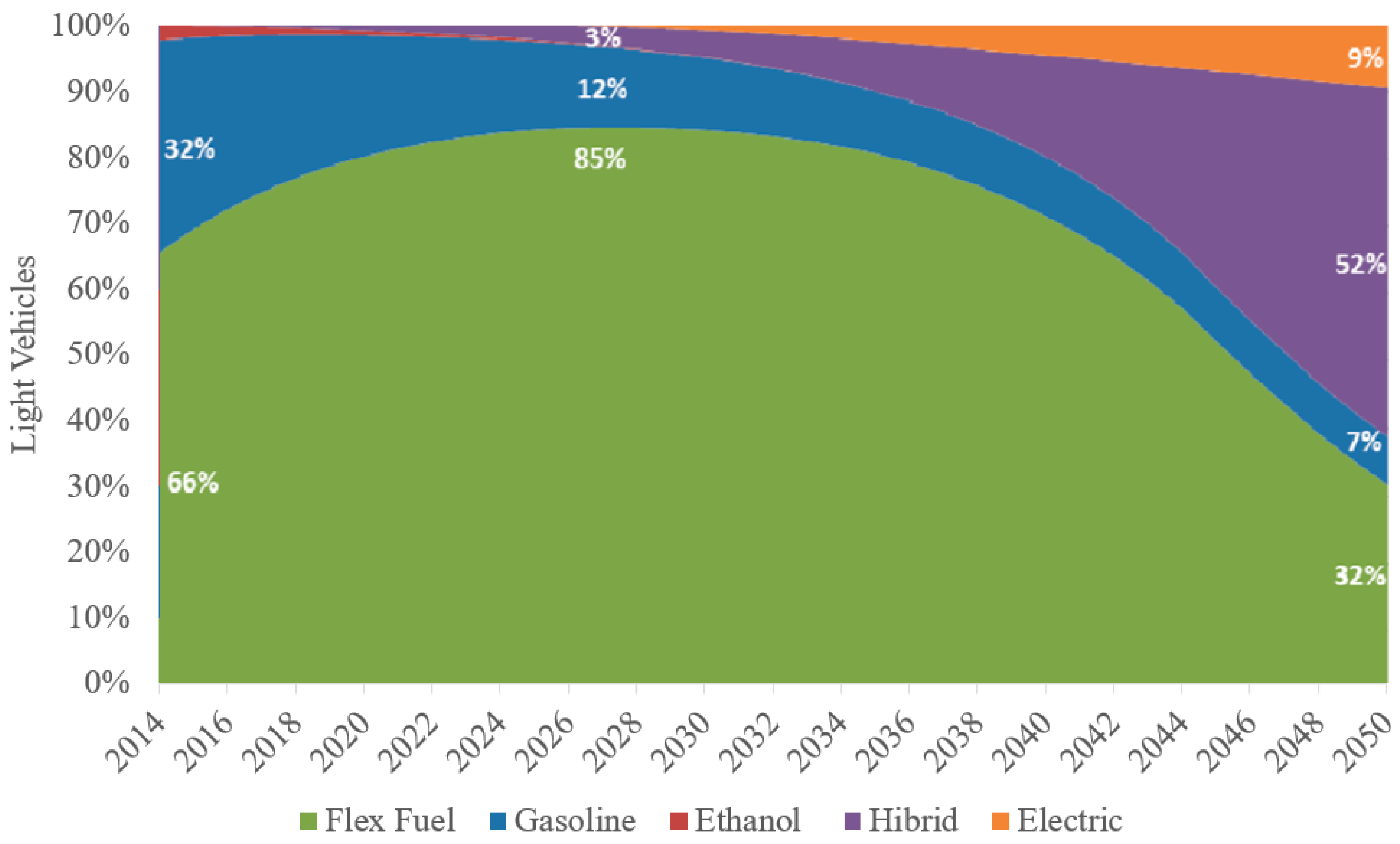
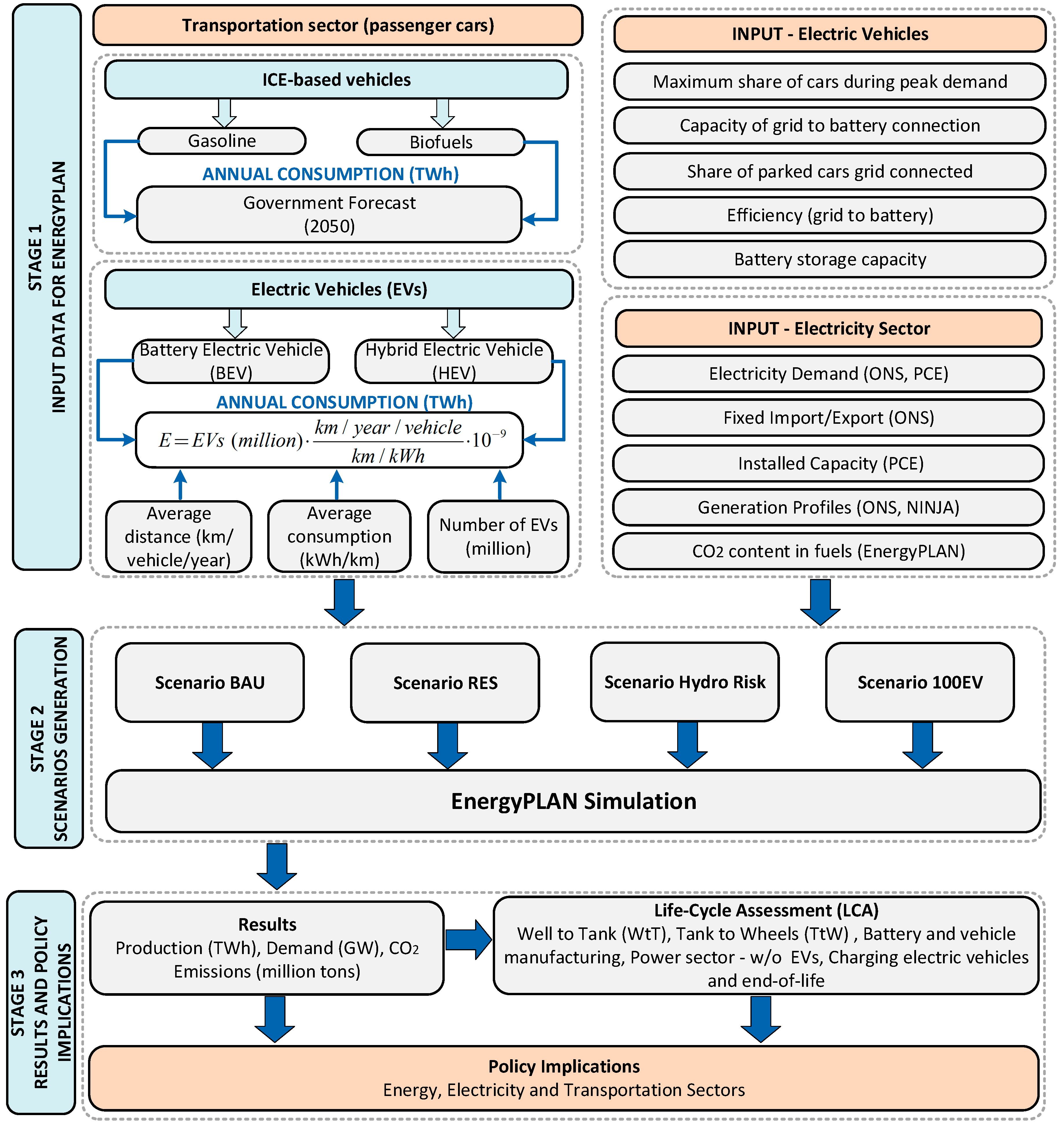



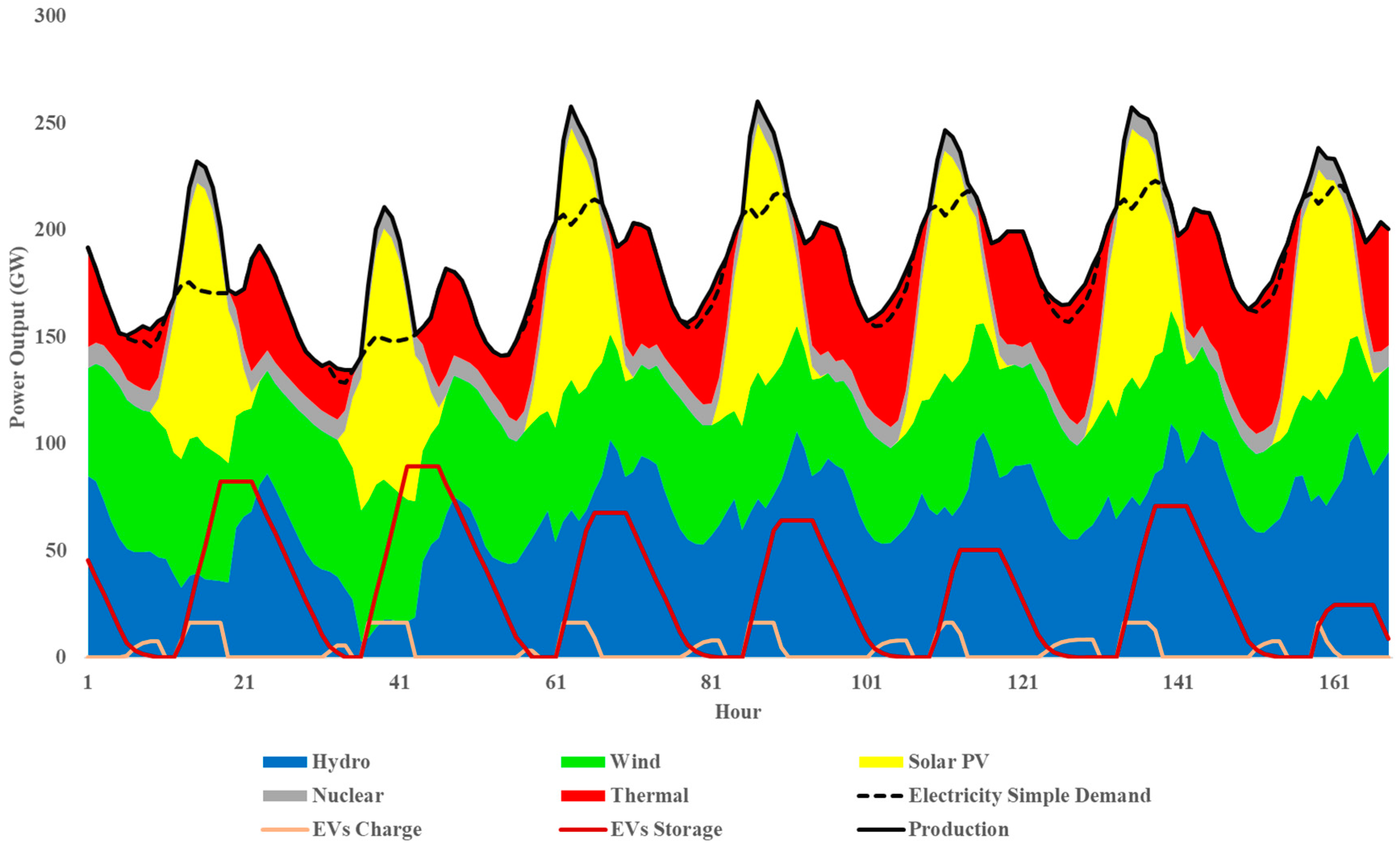
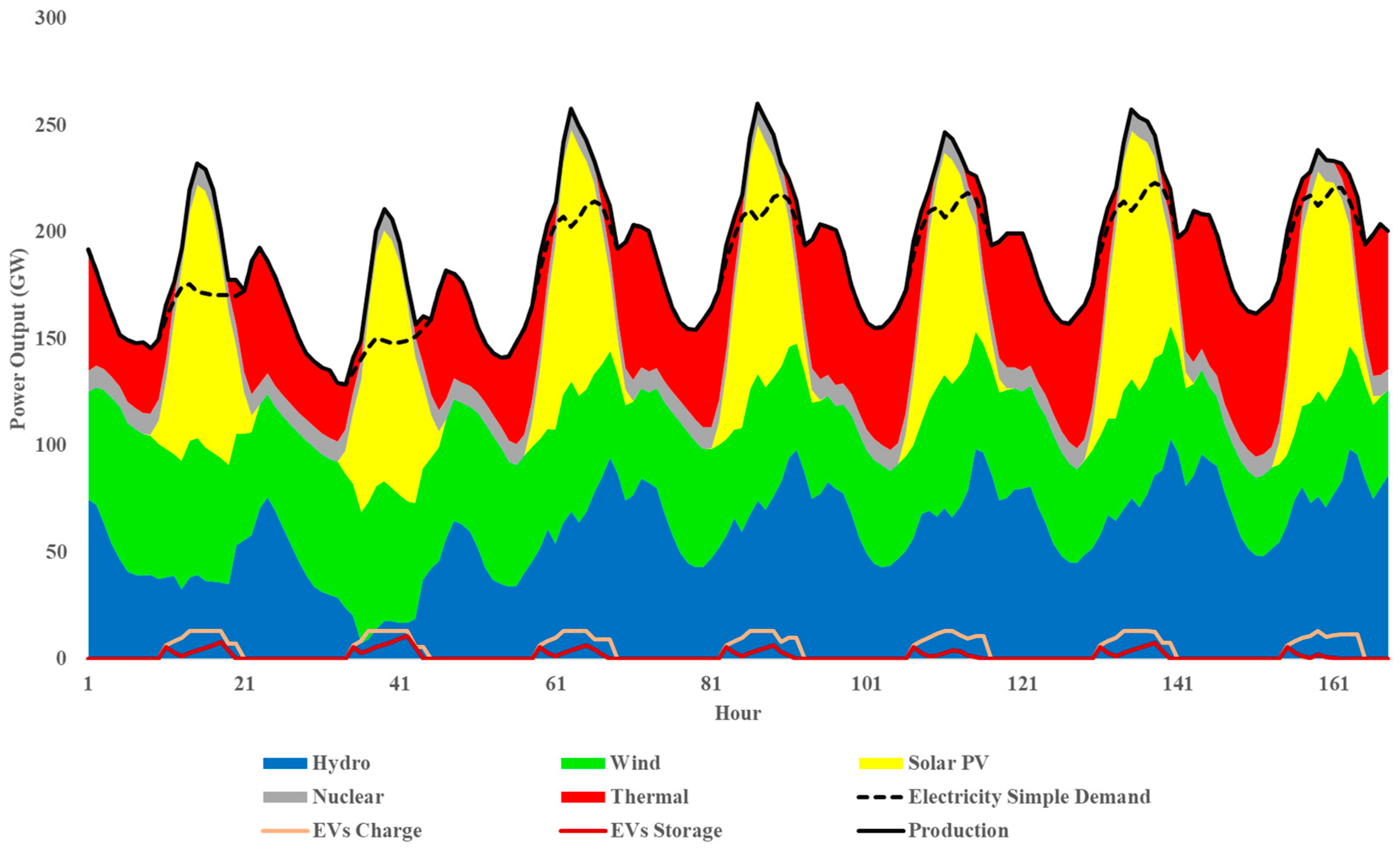

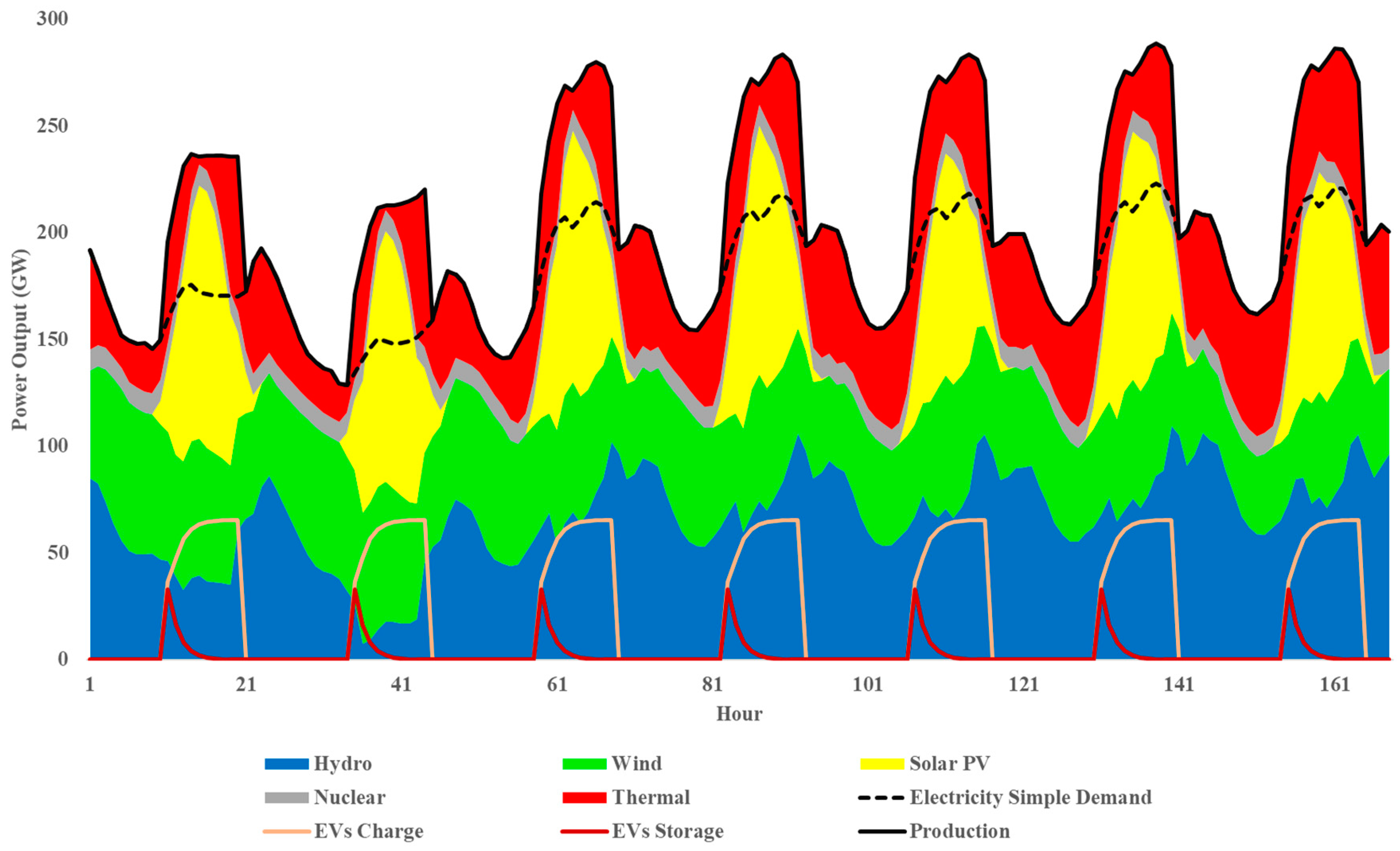
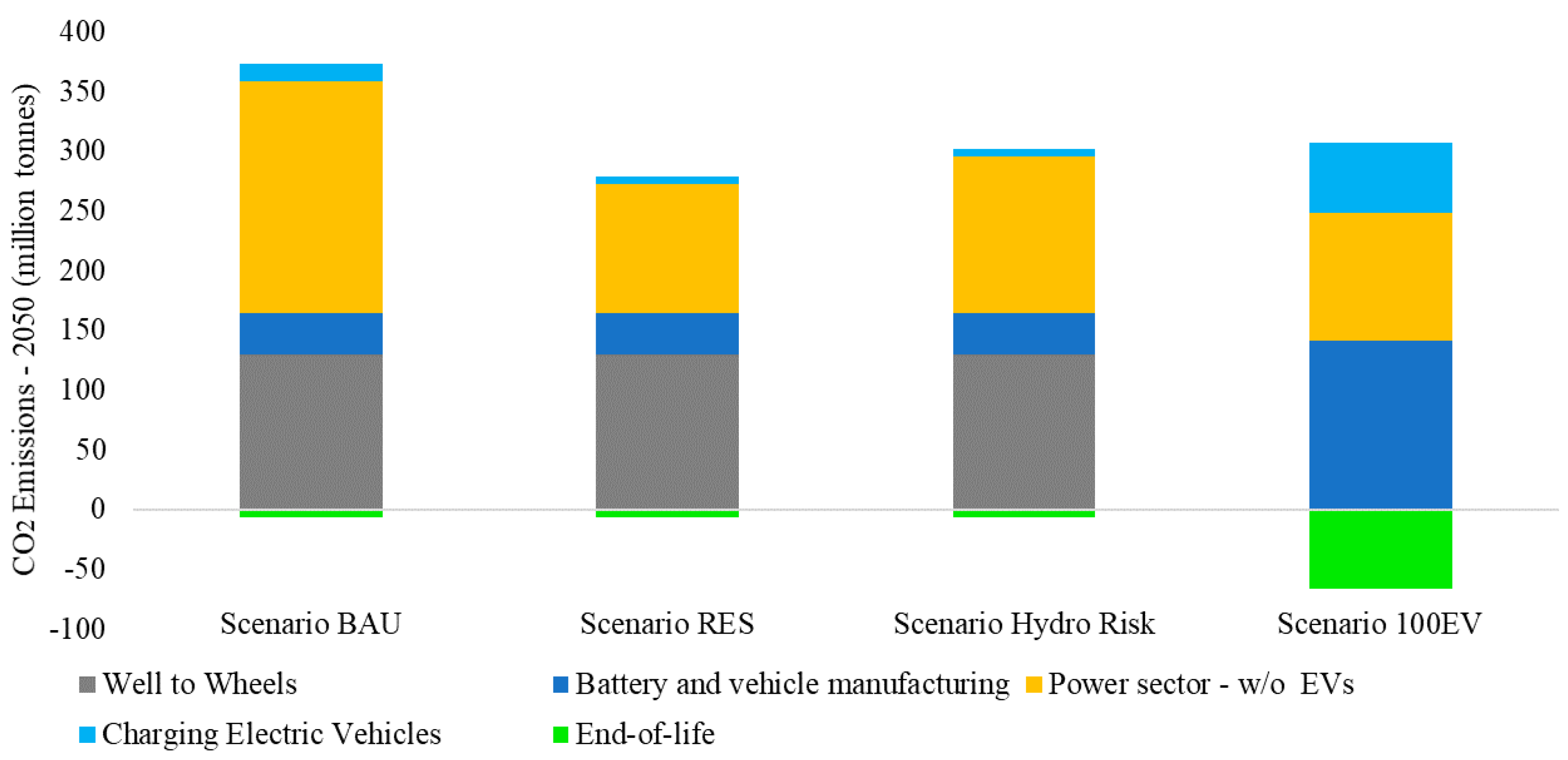
| EEEP (TWh) | CEEP (TWh) | |
|---|---|---|
| Scenario BAU | 0.0 | 0.0 |
| Scenario RES | 12.2 | 24.3 |
| Scenario Hydro Risk | 12.2 | 24.3 |
| Scenario 100EV | 0.9 | 0.0 |
© 2020 by the authors. Licensee MDPI, Basel, Switzerland. This article is an open access article distributed under the terms and conditions of the Creative Commons Attribution (CC BY) license (http://creativecommons.org/licenses/by/4.0/).
Share and Cite
Dranka, G.G.; Ferreira, P. Electric Vehicles and Biofuels Synergies in the Brazilian Energy System. Energies 2020, 13, 4423. https://doi.org/10.3390/en13174423
Dranka GG, Ferreira P. Electric Vehicles and Biofuels Synergies in the Brazilian Energy System. Energies. 2020; 13(17):4423. https://doi.org/10.3390/en13174423
Chicago/Turabian StyleDranka, Géremi Gilson, and Paula Ferreira. 2020. "Electric Vehicles and Biofuels Synergies in the Brazilian Energy System" Energies 13, no. 17: 4423. https://doi.org/10.3390/en13174423
APA StyleDranka, G. G., & Ferreira, P. (2020). Electric Vehicles and Biofuels Synergies in the Brazilian Energy System. Energies, 13(17), 4423. https://doi.org/10.3390/en13174423







